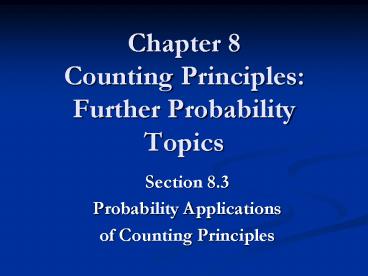Chapter 8 Counting Principles: Further Probability Topics - PowerPoint PPT Presentation
1 / 9
Title:
Chapter 8 Counting Principles: Further Probability Topics
Description:
Chapter 8 Counting Principles: Further Probability Topics Section 8.3 Probability Applications of Counting Principles Recall that tree diagrams can be used to solve ... – PowerPoint PPT presentation
Number of Views:89
Avg rating:3.0/5.0
Title: Chapter 8 Counting Principles: Further Probability Topics
1
Chapter 8Counting Principles Further
Probability Topics
- Section 8.3
- Probability Applications
- of Counting Principles
2
- Recall that tree diagrams can be used to solve
probability problems involving dependent events,
but tree diagrams sometimes require a large
number of branches. - Permutations and combinations are especially
helpful when the numbers involved are large.
3
- The use of combinations to solve probability
problems depends on the basic probability
principle - Let S be a sample space with equally likely
outcomes, and let event E be a subset of S. Then
the probability that event E occurs, written
P(E), is - where n(E) and n(S) represent the number of
elements in sets E and S.
4
- Combinations tend to be used more often than
permutations in probability because many times
the final result does not depend on the order of
events. - However, order does matter in some cases, and
permutations would need to be used. - In some cases, a mixture of permutations and
combinations are needed to solve the problem.
5
- Example You and your friends order twelve
burritos to go from a Mexican restaurant, five
with hot peppers and seven without however, the
restaurant forgot to label them. If you pick
three burritos at random, what is the probability
that all three have hot peppers? - Find the number of ways you can choose 3
burritos from 12. - 12C3 220 This is your sample
space. - Find the number of ways you can choose 3
burritos with hot peppers. - 5C3 7C0 10
- P(3 w/hot peppers) __10__ 0.045
- 220
6
- Example A basketball coach was asked to rank
order his top three players from the starting
five players. Suppose one of the players is
named Jack. - a.) What is the probability that Jack is one of
the top - three players?
- Find the number of ways the top 3 players can be
chosen. - 5C3 10 This is your sample space.
- Find the number of ways that Jack could be
chosen as one of the three ranked players. - 4C2 6 Since we want Jack to be one of the
three chosen players, we only need to find
out how many ways the coach can select the other
two from the remaining 4 players. - Determine the probability Jack is one of the top
three. - P(top three) 6 0.6
- 10
7
- Example A basketball coach was asked to rank
order his top three players from the starting
five players. Suppose one of the players is
named Jack. - b.) What is the probability that Jack is ranked
1? - Find the number of ways the top 3 players can be
ranked. - 5P3 60 This is your sample space.
- Find the number of ways that Jack could be chosen
as the - number one ranked player.
- _1_ 4 3 12
- Since we want Jack to be the number one ranked
player, we only need to find - out how many ways the coach can select the second
and third ranked players - from the remaining 4.
- Determine the probability Jack is the top-ranked
player. - P( rank 1 ) 12 0.2
- 60
8
- Example A standard poker hand consists of 5
cards. Find the probability that a person is
dealt a straight flush (5 in a row in a single
suit, but not a royal flush). Assume Aces are
either high or low. - A flush could start with an Ace, 2, 3, 4, 5, 6,
7, 8, or 9. - This gives 9 choices in each of 4 suits, so
there are 36 choices in all. ( 9 4 36 ) - P(straight flush)
___36____ 52 C 5
36______ 2, 598, 960
-5
0.00001385 1.385 x 10
9
- Example Two hundred people apply for three
jobs. Sixty of the applicants are women. If
three persons are selected at random, what is the
probability that - a.) all are women?
- b.) exactly two are men?
- c.) at least one is female?































